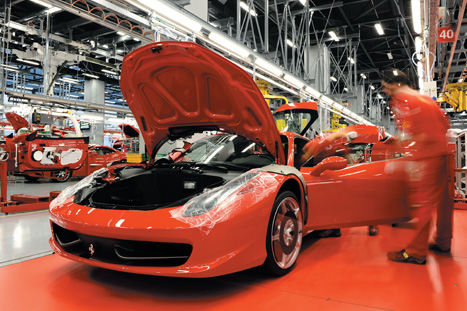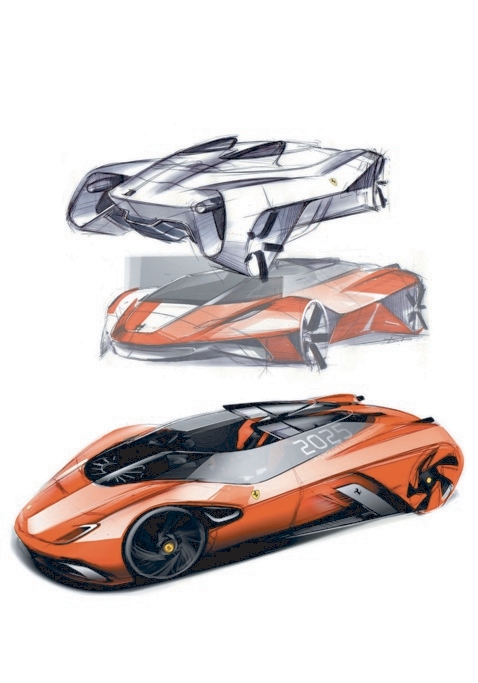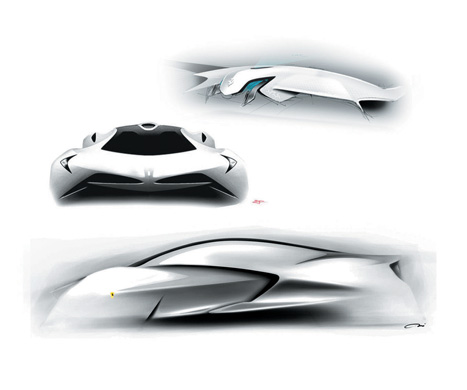Posing for photographs in front of the factory gates that bear the name Ferrari is a must when visiting the nearby Museo Ferrari in Maranello.
Devotion to the brand owes as much to Ferrari’s Formula One (F1) team winning 31 world titles as it does to what Ferrari chairman Luca di Montezemolo describes as the ’beauty, tradition and longevity’ of its road cars.
Ferrari thrives on excellence, and this year it challenged the world’s design students to imagine the ’hypercar of the future’. Their response was to add a shade of green to the iconic red marque.

The Ferrari World Design Contest 2011 asked students from 50 design schools to create the Ferrari of 2025: a car that must be hyper light, hyper fast, hyper technological and hyper ecological.
’We wanted the students to try to understand the feelings and emotions of the third-millennium man and to anticipate social and technological changes that may have occurred by 2025,’ said Ferrari director of design Flavio Manzoni, whose department organised the competition. ’We asked the students to design, plan and maximise the performance of Ferrari vehicles at all levels; to create a pure hypercar that relies on the state of the art.’
More than 200 entries were submitted, and the judging panel whittled this down to seven finalist teams, including the Royal College of Art (RCA), which had three separate submissions vying for a prize.
Common to all teams was a requirement to create a virtual 3D model of their designs using Autodesk Alias, plus a one-quarter-scale physical model.
“We asked the students to design a pure hypercar that relies on the state of the art”
FLAVIO MANZONI, FERRARI
The result was a total of 21 new car designs brimming with ideas that fully explored the design brief. A centre fuselage based on that of a Ferrari F1 car to improve handling, power from two naturally aspirated turbo shaft engines ’derived from the turbo shaft engines used in the 2020 Ferrari F1 car’ and a high-performance electric vehicle (EV) with invisible batteries to lighten the car were three ideas that took students from Detroit’s College for Creative Studies and from the Istituto Europeo Di Design (IED) in Barcelona to the final.
A team from Hongik University in South Korea, comprising Kim Cheong Ju, Ahn Dre and Lee Sahngseok, won first prize for the Eternità, a two-seat sports car consisting of light-layered carbon surfaces, a flywheel energy storage system, a superconductive motor and a hydrogen generator.

Runner-up Samir Sadikhov from IED in Turin proposed small air turbines in the side intakes to charge the car’s interior devices.
Third place went to RCA’s Henry Cloke and Qi Haitao for the Cavallo Bianco. Aimed at growing markets in China and Russia, the ’hypercar for a frozen Riviera’ is designed to race over winter lakes and rivers.
Arguably possessing the most futuristic body design in the final, the latter’s proposed powertrain matched Ferrari’s demands for power through its combination of hybrid technologies.
Cloke, a graduate in automotive design from Coventry University, told The Engineer that the F1-inspired turbo-charged V6 engine would run on bio-ethanol to generate electrical power passing through a battery to eliminate turbo lag in a series-hybrid configuration. He said this would keep the battery small and light as it only has to store power for when the engine is off boost; it is always being charged so is kept warm enough to work, even in very cold temperatures.
An electric motor at every wheel then provides maximum grip in icy conditions and reduces weight by removing the need for a mechanical four-wheel-drive system.

Manzoni and Ferrari chairman Luca di Montezemolo were impressed by the quality of entries, with the latter stating that some of the ideas could make it into future vehicles. Manzoni said: ’There were many good ideas: man-machine interfaces, hybrid systems and whole solutions such as reconfigurable soft skin, where the skin changes shape depending on the situation.’
The South Korean winner’s package includes an internship at Ferrari’s Maranello plant, where Ferraris and Maseratis are assembled for the high-net-worth motorists who contributed to the company gaining revenues of €491m (£428m) and a trading profit of €53m in the first quarter of this year.
Ferrari’s aim of creating and selling the fastest, lightest and most technologically advanced cars might seem at odds with the hybrid designs offered by students in the World Design Contest, given the company’s reputation for designing cars powered with thirsty V8 and V12 engines.
Dr James Marco from Cranfield University’s department of automotive engineering told The Engineer that automotive manufacturers’ emissions standards are based on the fleet average and that Ferrari’s emissions are offset against the Fiat 500 and the Fiat Punto.
However, the company has identified what it describes as future CO2 emissions standards particularly in urban environments and is taking measures to reduce fuel consumption and emissions.
It is doing this by looking to its recent racing heritage, thereby bringing more eco-friendly technologies into its cars without compromising its performance criteria.
According to parent company Fiat, street-legal Ferraris can already run on fuels with up to 10 per cent ethanol with no engine modifications required, and in 2008 Ferrari unveiled the F430 Spider Bio Fuel prototype at the Detroit Motor Show.
The company used its experience in F1, where technical regulations require cars to run on fuel with 5.75 per cent biomass-derived content, plus the FIA GT Championships and the American Le Mans Series, which require cars to use fuels with 10 per cent ethanol (E10), to develop the engine. Engineers modified the engine control unit so the two types of fuel could run at the same compression ratio and developed a vehicle capable of delivering five per cent fewer CO2 emissions.
Fiat’s 2010 Sustainability Report states that, by 2012, Ferraris should emit 40 per cent less CO2 but stops short of aiming for zero emissions via electrification. ’I can’t imagine a full electric Ferrari,’ said Manzoni. ’Personally, I don’t believe in electricity as the future because in my opinion we simply move a problem from one place to another. There are other ways to combine performance with respect for our planet. Remember, last year we presented the 599 with KERS [kinetic energy recovery systems], which was the first hybrid Ferrari.’
The experimental HY-KERS vettura laboratorio (a 599 GTB Fiorano) is claimed to offer up to 35 per cent fewer CO2 emissions and is slated for production in 2014.
HY-KERS derives its hybrid power from a V12 engine and a 100hp electric motor weighing 40kg, which is coupled to the rear of the dual-clutch seven-speed F1 transmission. According to the company, the algorithms and control logics controlling the torque, traction and braking distribution functions are directly derived from F1.
Marco agrees F1 is playing a significant role in the technological development of its road cars. ’As the requirements change in F1 and they move towards higher-powered KERS people would expect that to trickle down to their road-going versions,’ he said.
Marco believes Ferrari might one day present an all-electric-drive vehicle, drawing parallels with diesel engines in terms of acceptance from premium manufacturers. ’People were saying the same thing about diesel engines 10 years ago: that there would never be a Jaguar diesel… but now we’re seeing quite high-performance vehicles with diesel engines,’ he said. ’The restriction [with EVs] is still the energy storage, power capability of the battery and the weight. What you can do in terms of vehicle dynamics and handling - key to the Ferrari brand - presents a wealth of opportunities.’
back story - emotion control
HELE technology is designed to respond to a motorist’s driving style
Last year saw the introduction of the High Emotions Low Emissions (HELE) system at the Paris Motor Show.
First employed on the California, HELE (in concert with Start & Stop) represents a series of innovations that respond to a motorist’s driving style and is said to reduce CO2 emissions by 14.5 per cent.
The central processing unit in the gearbox identifies the motorist’s driving style and adapts gear shifts to match.
Start & Stop restarts the car in 230ms. The driver can restart the engine by either releasing the brake pedal, engaging the accelerator pedal or using the UP paddle on the steering wheel.




Poll: Should the UK’s railways be renationalised?
I _do_ remember British Rail - and that it was <i>literally</i> a national joke https://youtu.be/zV2lmSDKvO8